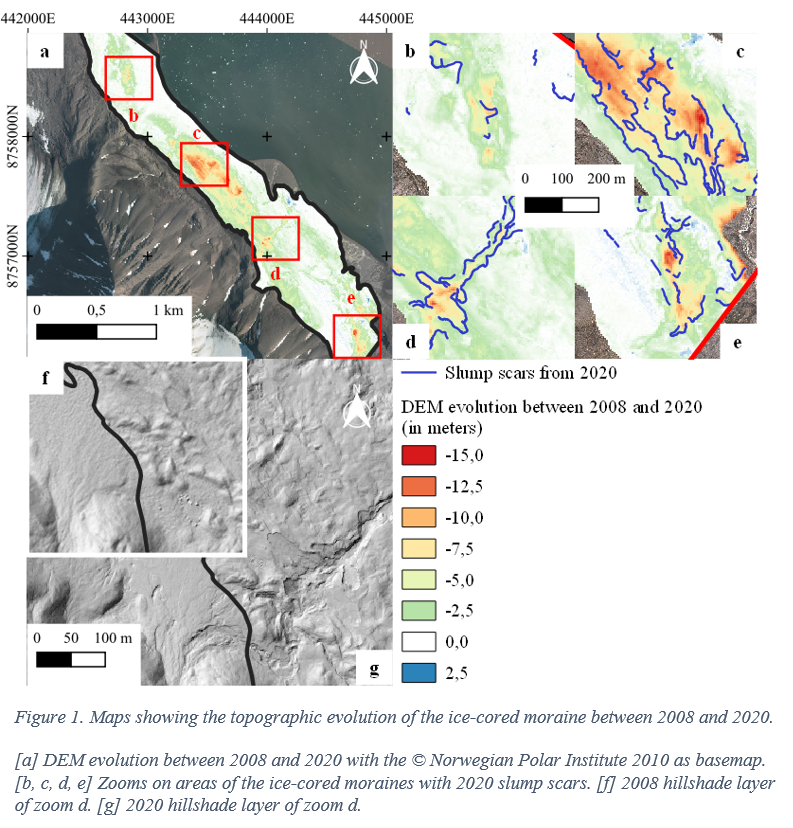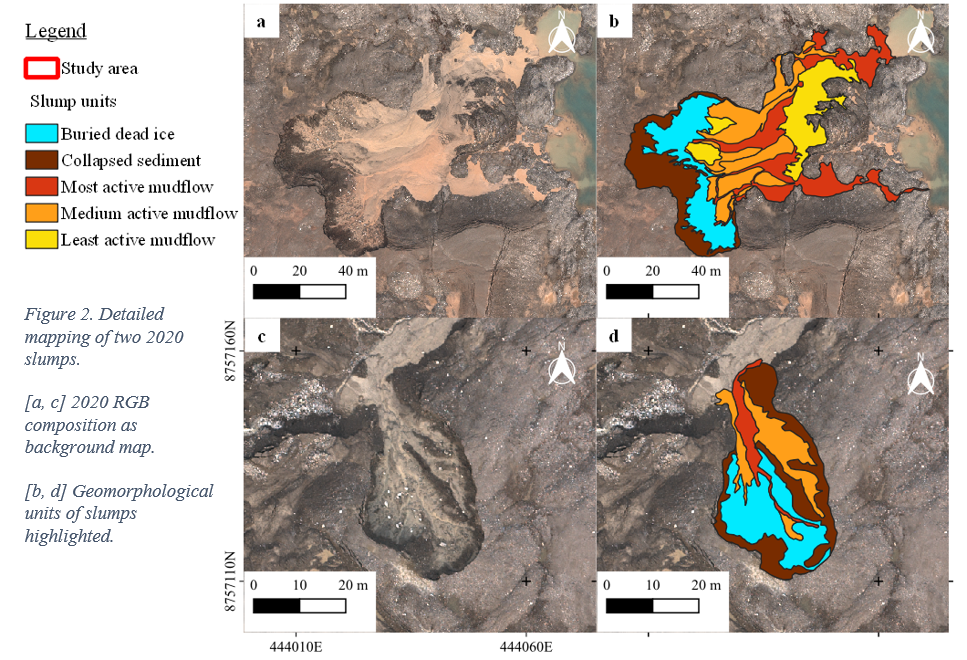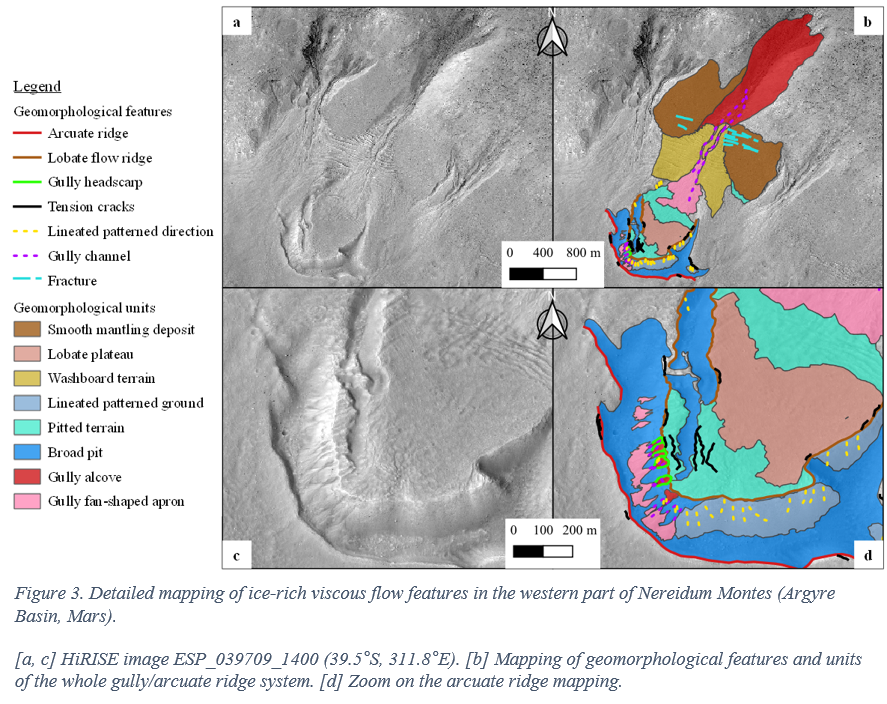Degradation processes on ice-cored moraines on Svalbard: a terrestrial analog for Mars
- 1DLR, Institute of Planetary Research, Berlin, Germany (marine.dsj30@gmail.com)
- 2Institut für Planetologie, Westfälische Wilhelms-Universität, Münster, Germany
- 3Department of Earth Sciences, University of Gothenburg, Gothenburg, Sweden
- 4Department of Earth Sciences, Università di Pisa, Pisa, Italy
- 5LPG, CNRS-Univ.,Nantes, France
The mid-latitudes of Mars host a large amount of buried ice deposits [1], which bear a record on the very Late Amazonian climate evolution (~107 to 108 yr.) [2] and are a possible resource for future exploration [3]. The reconstruction of the history of these ice reservoirs and the characterization of their current state is critical to enable putting constraints on the interplay between climate change, volatile migration and landform evolution. Examination of terrestrial analogs can help to identify similarities and – equally important – differences between the response of buried ice on Mars and Earth to changing environmental parameters. Here we report on our long-term investigations of an ice-cored moraine on Svalbard, a proxy for mid-latitude debris-covered glacier on Mars [4].
Our study area is an ice-cored lateral moraine of Kongsvegen glacier on the southern shore of Kongsforden in NW Spitsbergen (Svalbard). This site is subject to rapid degradation by melting and redistribution of surficial sediment, e.g., by thaw slumps and debris flows [5]. We couple multi-year fieldwork with repeat remote-sensing observations. Fieldwork includes DGPS-supported monitoring of surface changes by several imaging methods comparisons to environmental data (e.g., [6]). In 2008, a flight campaign with HRSC-AX (an airborne version of DLR’s High Resolution Stereo Camera on Mars Express) provided orthoimages (20 cm/px) and a Digital Elevation Model (DEM; 50 cm ground sampling distance, GSD) [7]. In 2020 a repeat campaign with DLR’s MACS (Modular Airborne Camera System) achieved ground pixel sizes between 5 cm and 10 cm for RGB images, and 10 cm to 15 cm for NIR images. The associated DEM has the same resolution [8]. MACS also acquires TIR data,which we use to identify regions with anomalous temperatures (e.g., exposed ice). We use for detailed mapping of ice-rich viscous flow features on Mars [9]. This study focuses on the Nereidum Montes area in the northern part of the Argyre basin. Image analysis, mapping of landforms and documentation of results were carried out using the QGIS software.
A difference DEM was generated to determine the elevation differences (i.e. volume changes) on the ice-cored moraine between 2008 and 2020. Hillshade layers were created for each dataset to facilitate quick visual identification of morphological changes. Slump scars were digitized in 2008 and 2020 on orthoimages and hillshade views, and prominent slumps of 2020 (most recent, visible and best preserved) have been geomorphologically mapped with a focus on buried dead ice, collapsed sediment, and the relative activity of mud flows. Image analysis and mapping of Martian landforms is currently ongoing.

There are 4 areas of major activity within the ice-cored moraine (Fig.1.a) highlighted by the four red boxes b, c, d and e, with more than 10m of elevation losses. There are many areas showing a neutral balance in terms of topographic evolution (white pixels). Hillshade layers from 2008 (Fig.1.f) and 2020 (Fig.1.g) correspond to the area of box d and show that significant changes have occurred in 12 years, indicating a massive degradation of ice-cored moraine in the last decade. This also demonstrates that the general trend is towards a heterogenous loss of material. The slump scars appear to be concentrated in the same areas described above. In 2008, 85 scars were counted against 157 scars in 2020, i.e. almost twice as many. It also appears that the 2020 scars are following the outlines of high activity areas while the 2008 scars are within these areas.

Regarding the detailed mapping of slumps, the area corresponding to the buried dead ice, mapped with the TIR channel, can vary in shape and size depending on the shape of headscarp and the other units, i.e. the collapsed sediments and the mudflows (Fig.2.b,d). The collapsed sediments are washed away by the mudflows. The mudflow seems more active near the previously exposed dead ice. Therefore, the degradation of ice-cored moraines takes place mainly through the melting of the ice, which leads to mass wasting and rapid degradation. As Mars does not have the same climatic conditions, it is interesting to see whether the same landforms can be found on it at a very local scale.

The Mars case study displays gullies, arcuate ridges with small gullies superposed on their slopes, flow features and also possible sublimation features such as pitted terrain, broad pits, and lineated patterned ground (Fig.3.b). The area is also filled with washboard terrain which is only found at steep slopes, above the lobate flow feature. It is marked by a close alternation of closely-spaced scarps which are parallel to the contour lines (possible evidence for paraglacial sacking [10]). Tension cracks are also found at the ridges and parallel to gully headscarps indicating recent activity. These tension cracks may be similar to headscarp retreats on backwasting processes on ice-cored moraines (Fig.3.d). The ice-cored ridge or arcuate ridge may still undergo degradation. The first results show that the degradation processes are rather related to potential ice sublimation and that signs of melting ice, if they exist on Mars, are not strongly encountered, which is consistent with the studies on very Late Amazonian climate evolution.
References
[1] Levy, J. S. et al. (2014), J. Geophys. Res. Planets, 119, 2188– 2196. [2] Bramson, A. et al. (2021), Bull. Amer. Astron. Soc., 53(4), e-id. 115. [3] Putzig, N. et al. (2022) LPSC 53, #2443. [4] Petersen,E. et al. (2017) LPSC 48, #2966. [5] Bennett, M. et al. (2000) Geomorphology, 35, 21-40. [6] Boike, J. et al. (2018), Earth Syst. Sci. Data, 10, 355–390. [7] Hauber, E. et al. (2011), Geological Society of America, 483, 177–201. [8] DLR - Institut für Optische - Sensorsysteme, (2020). [9] Souness, C. and Hubbard, B. (2012), Progress in Phys. Geog. 36(2), 238-261. [10] Jawin, E. R. et al. (2018), Icarus, 309, 187-206.
How to cite: Desjardins, M., Hauber, E., Bucher, T., Geßner, M., Hiesinger, H., Schmedemann, N., Johnsson, A., Ellermann, F., Sassenroth, C., Brauchle, J., Conway, S., and Noblet, A.: Degradation processes on ice-cored moraines on Svalbard: a terrestrial analog for Mars, Europlanet Science Congress 2022, Granada, Spain, 18–23 Sep 2022, EPSC2022-1035, https://doi.org/10.5194/epsc2022-1035, 2022.

